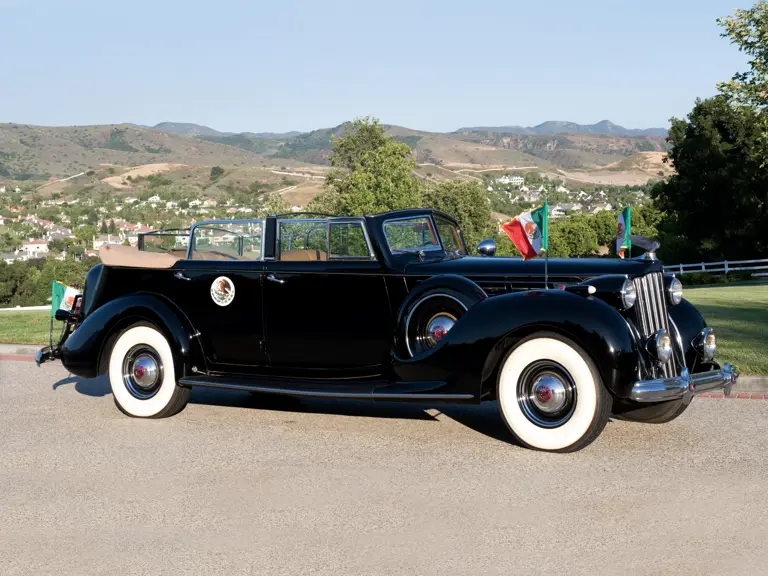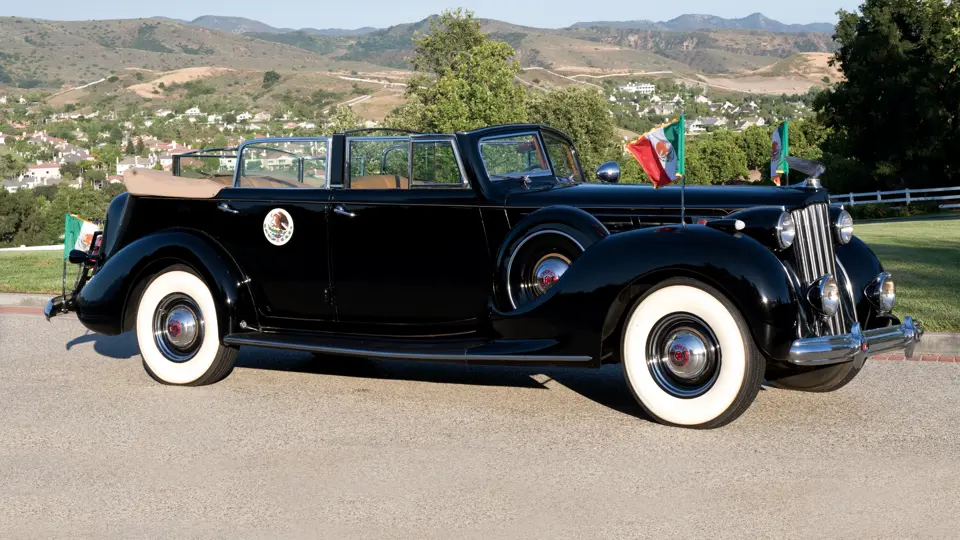Series 1708. 175bhp, 473.3 cu. in. L-head V12 engine, three-speed manual transmission, coil spring independent front and semi-elliptic leaf spring rear suspension, four-wheel hydraulic drum brakes with vacuum booster. Wheelbase: 139.5"
“Fit for a king” aptly describes a Daimler or Rolls-Royce, or, on another continent in another time, a Hispano-Suiza. With an addiction to alliteration, however, one can argue that nothing could be more presidential than a Packard. It was fitting, then, that Mexican President Lázaro Cárdenas del Río was presented with a Packard Twelve convertible sedan during the penultimate year of his presidency.
Packard had long been the sales leader in the triumvirate called the “Three Ps” of prestige American auto manufacture: Packard, Peerless and Pierce-Arrow. Packard’s business gained momentum with the four-cylinder Model 30 of 1907, and took another jump with the move into six-cylinder territory in 1911. But the car that made Packard’s name for a generation was the Twin Six of 1916-1923, a massive 424 cubic inch car. By the early 1920s, however, it was outmoded and ready for change.
Packard took a giant step the next year with the Single Eight, the first of the modern inline eights with balanced crankshafts. Smaller in displacement than the Twin Six, it made nearly as much power, and was lighter and more responsive. The straight eight became Packard’s staple powerplant for the next three decades. In 1930, however, Cadillac introduced a new multi-cylinder engine, a V16. Moreover, Pierce Arrow and middle-priced Auburn had them in the works. In response Packard decided to revive the V12. Ready for the 1932 model year, the new Twin Six met the challenge with a completely new engine. A 67-degree vee, the new powerplant displaced 445 cubic inches, just 20 more than the old engine, but developed 75 percent more power. In 1933 the name was changed to simply “Packard Twelve,” and two years later displacement rose to 473.3 cubic inches, making 175 bhp. Packard Twelves received coil spring front suspension and hydraulic brakes for 1937, as well as a vacuum-assisted clutch. In addition to production bodies and chassis sent for custom coachwork, Packard cataloged a number of styles from the major coachbuilders, among them LeBaron, Rollston , Brunn and Dietrich.
Of these, perhaps the most closely associated with Packard is Dietrich. Raymond Dietrich was hired by Brewster as a draftsman in 1913. He worked briefly for Chevrolet in New York before GM took over the marque from Billy Durant, then went back to Brewster until he and colleague Thomas Hibbard left to form LeBaron. In 1925, LeBaron’s best customer, Lincoln president Edsel Ford, lured Dietrich to Detroit in hopes of acquiring the whole LeBaron operation. Dietrich went alone on the trip, his partner Ralph Roberts (Hibbard, the third partner, had departed for Paris) remaining home due to illness. Dietrich was wooed and won in the Motor City and ended up with a 50 percent share in a new company called Dietrich, Inc. Partly owned by Murray Corporation of America, a production body company, the new Dietrich firm created designs and built bodies for Lincoln, Packard and such other automakers as wanted to buy them. By 1927, Raymond Dietrich had styling consultancies with Lincoln, Studebaker, Franklin and Dodge. With the Chrylser buyout of Dodge in 1928, the new Chrysler Corporation was added to Dietrich’s list of clients. In 1931, however Raymond Dietrich was forced out of his own company. He ended up going to work for Chrysler in their corporate styling studio. Meanwhile, Murray ran Dietrich, Inc., which was less and less a coachbuilder and more a design house. The last Dietrich bodies were built in Murray’s shops, although the Dietrich label was used until the late 1930s. Among the Dietrich designs used on Packard was the convertible sedan, Style Number 1253 in model year 1939.
Born to a middle class family in the Mexican state of Michoacán, Lázaro Cárdenas supported the family from age 16, after his father died. Although he had left school at age 11, he continued to educate himself and read extensively throughout his life. He was drawn to politics during the Mexican Revolution around 1913, when Victoriano Huerta overthrew President Francisco Madero. A supporter of Laborist Party politician Plutarco Elías Calles, Cárdenas became governor of Michoacán after Calles was elected Mexican President.
After Calles left the presidency in 1928 and a succession of puppet regimes, Cárdenas was selected as the Party of the Mexican Revolution’s presidential candidate in 1934. After winning the election, he proved to be a reformer, his government abolishing capital punishment and bloodlessly ending the Revolution that had been simmering since 1910. Cárdenas is credited by many with establishing the Mexican political system in place until the end of the 1980s. He founded the state petroleum company, Petróleos Mexicanos (Pemex) and the National Polytechnic Institute. After his presidential term ended in 1940, he served as Mexican Secretary of Defense until 1945.
The Packard was a gift from Cárdenas’s close friend Ofario, a businessman and Packard representative. Cárdenas was not a president to hide from his people, but the times called for a measure of security. Accordingly, bulletproof glass was fitted to the convertible sedan, including retractable side and rear windscreens for use with top up or down.
Restored many years ago, Cárdenas’s Packard is still in very good condition. It is finished in black lacquer, with interior of tan leather and a tan Haartz cloth top. Purchased in March 2000 by a prominent California collector, it has been carefully maintained and serviced as needed. During 2005 it was on exhibit at the Petersen Automotive Museum in Los Angeles for their exhibition “Presidents, Popes and Potentates: Cars of Heads of State.” A singular example of the last of the Packard Twelves, this car exudes power and prestige. It is, without a doubt, a Packard with provenance.



 | Monterey, California
| Monterey, California


